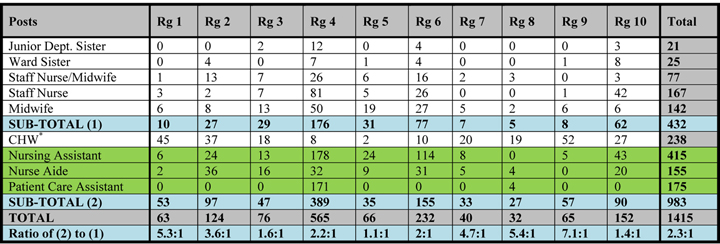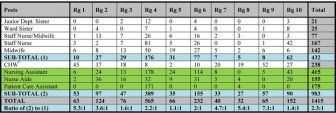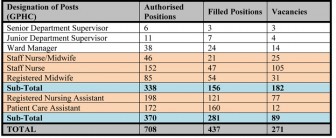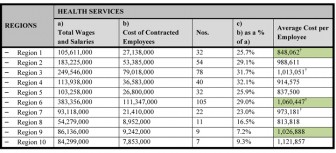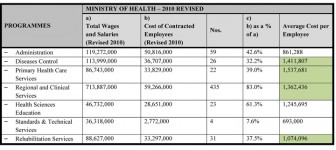The debate between the Guyana Nurses’ Association and the Ministry of Health needs to be better enlightened, if only for the benefit of those persons who are likely, however reluctantly, to be patients of public health facilities.
There appears to be some confusion about whether the discussion is about (trained/certified) nurses, ‘trainees’; or the prevalent nursing aides, nursing assistants and patient care assistants, who constitute a low and generally indifferent level of service hardly geared to assure restoration to health and, more importantly, educationally ill-equipped to absorb a higher level of training that will upgrade their ‘skill’ to the level of a qualified nurse. As usual the actual distribution of the various nursing categories is being obscured.
Dated as it may appear the MoH would do well to revisit one of its reports which deals with the Guyana Health Workforce, as at December 2007. The review should allow opportunity to update the workforce data for the benefit, not so much for the disputants, but also to allay the apprehensions of stakeholders.
For starters the following Table provides a useful overview:
The numbers speak for themselves and deserve careful
Table: Guyana Public Health Sector – Geographical location of nursing posts and deployment of personnel, December 2007
* CHW – Community Health Worker
attention to the ‘nursing’ capacity in each Region at the time. As a whole, however, the Table shows that the qualified categories of nurses are outnumbered by just over 2:1 by their under-qualified counterparts.
Specifically with respect to the Georgetown Public Hospital Corporation, the Table following reflected the manning situation regarding the nursing cadre.
Table
Health Sector – Nursing Cadre – posts and staffing, December 2007
The above represents 38.3% vacancies at 2007, made up 12.6% of unqualified and 25.7% of qualified nursing categories.
In this connection the Report observed the following:
● The single greatest challenge to delivery of quality nursing care was the acute shortage of professional nurses.
● New nurses became easily frustrated in such an environment because of lack of support. Older nurses were therefore under enormous strain to cope with the volume of work and responsibility, and often had to take blame for the inevitable errors that were made.
● Little emphasis was placed on continuing education, resulting in poor performance and poor standards. (To address standards of care adequately, there must be a conscious effort to train and retrain staff so that knowledge could be updated. In addition there must be adequate equipment and supplies to support training at all levels, and accompanying human resources to deliver programmes).
In the mêlée a cause for concern would be the significant number of personnel contracted in the Public Health Sector. For example the 2011 National Budget showed the numbers and costs attributable to contract employees in i) the Regions; and ii) at GPHC respectively, in the Tables below:
Table
Regional Costs in relation to Total Wages and Salaries – 2011‡
† Increased over 2010
‡ Extracted from 2011 National Estimates
Table
Georgetown Public Hospital Corporation
Costs in relation to Total Wages and Salaries
Briefly the 2011 Estimates reflected the relatively high proportion of contracted employees in the following Programmes:
Table
Cost of Contracted Employees in MoH Programmes – 2010
The Minister is reported to have commented on Guyana’s qualified nurses being ‘grabbed’ by overseas institutions, without mentioning the obvious reason of those territories experiencing the migration syndrome in turn.
At the same time however, it is useful to note the following extract from the Report:
“There is no functioning database in place at the central Ministry or at the regional levels to effectively capture the attrition rate of health staff due to emigration or whatever reasons. Such data are not routinely compiled and hence are not available in reports for planning and decision making purposes in human resources management matters.
“There is little or no coordination between ministries of health, universities, training institutions and the population at large. Of particular significance has been the limited involvement of professional associations in ensuring good standards of practice, strengthening the case for continuing education, and supporting new approaches to the provision of heath care.
“. . . Within the health sector there is limited manpower planning capacity. Equally, there is a poor and outdated Human Resource development policy.”
In this connection the attrition rate for the four identified categories of nurses up to 2007 was shown as follows:
Attrition Analysis of Nursing Staff
Hopefully the above and other indicators could form a basis for the ministry, the Guyana Nurses’ Association, and indeed the Medical Council of Guyana, to conduct a joint evaluation of the efficacy of the current nursing structure and operations, and compose a credible programme of training, remedial and development interventions, the outcomes of which will redound to the more positive image of the health sector across-the-board.
Yours faithfully,
E B John
